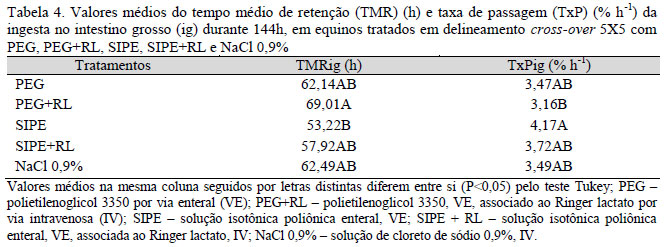The intestinal motility, frequency of defecation, moisture and appearance of feces, mean retention time (MRT) and passage rate (RP) of ingesta in the large intestine (li) were compared in five healthy mares treated with: polyethylene glycol 3350 in a single dose of 1.5g kg-1, in bolus, administered enterally (PEG); or for polyethylene glycol 3350 in a single dose of 1.5g kg-1, in bolus, enterally, associated to the Ringer lactate, 15ml kg-1 h-1 by continuous flow of 12 hours, intravenously (PEG+RL); or for enteral isotonic polionic solution, 15ml kg-1 h-1 by continuous flow of 12 hours, enterally (SIPE); or for enteral isotonic polionic solution, 7,5ml kg-1 h-1 by continuous flow of 12 hours, enterally, associated to the Ringer lactate, 7.5mL kg-1 h-1 by continuous flow of 12 hours, intravenously (SIPE+RL); or sodium chloride 0.9 %, 15ml kg-1 h-1 by continuous flow of 12 hours, intravenously (NaCl 0.9%). PEG treatment only slightly softened feces. PEG+RL, SIPE+RL and NaCl 0.9% were more effective in softening the feces and increasing the frequency of defecation than PEG. SIPE was the best to increase the frequency of defecation, to soften the feces, and reduce the TMRli, increasing RPli. It is concluded that the five treatments demonstrated a laxative effect, but SIPE was the most effective.
equines; laxatives; polyethylene glycol; solutions




